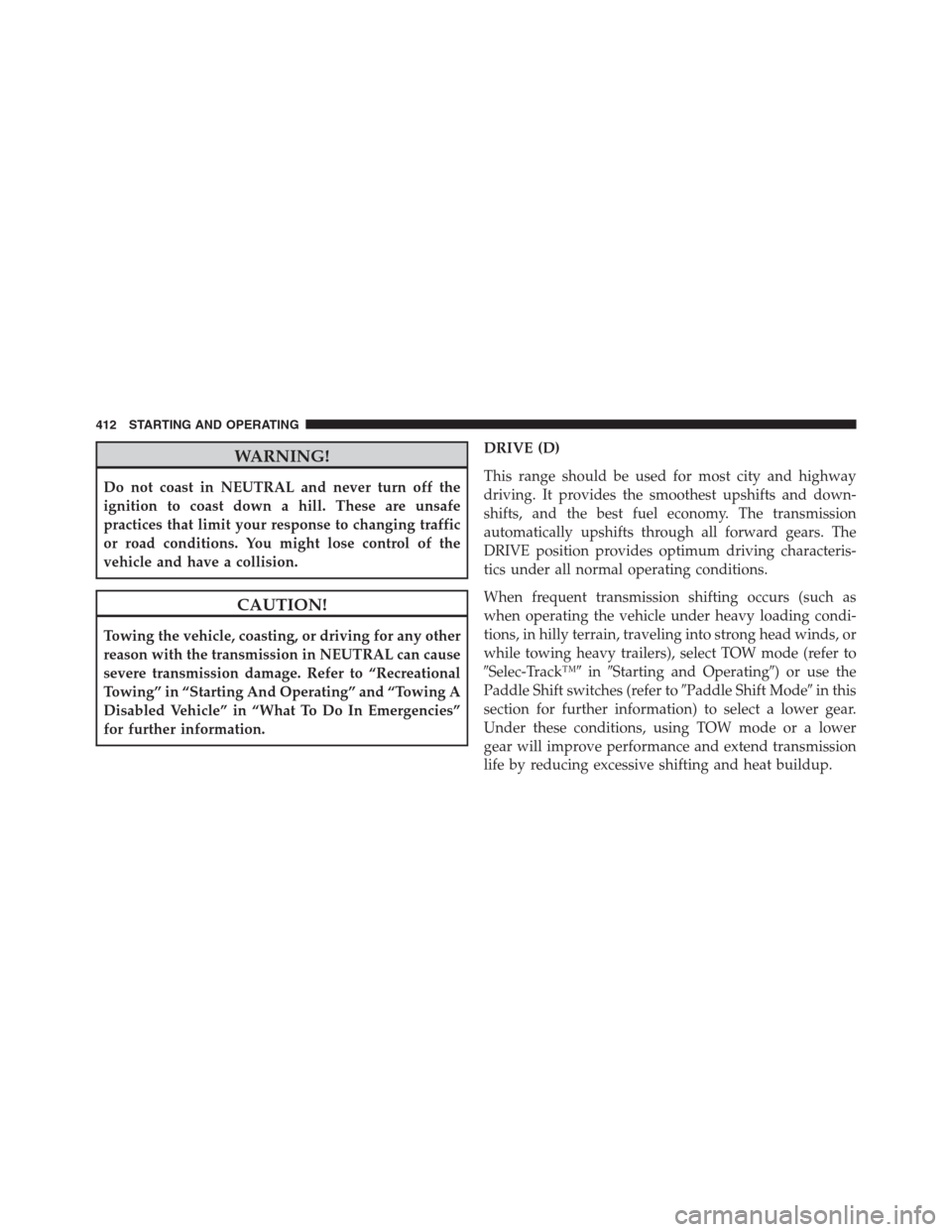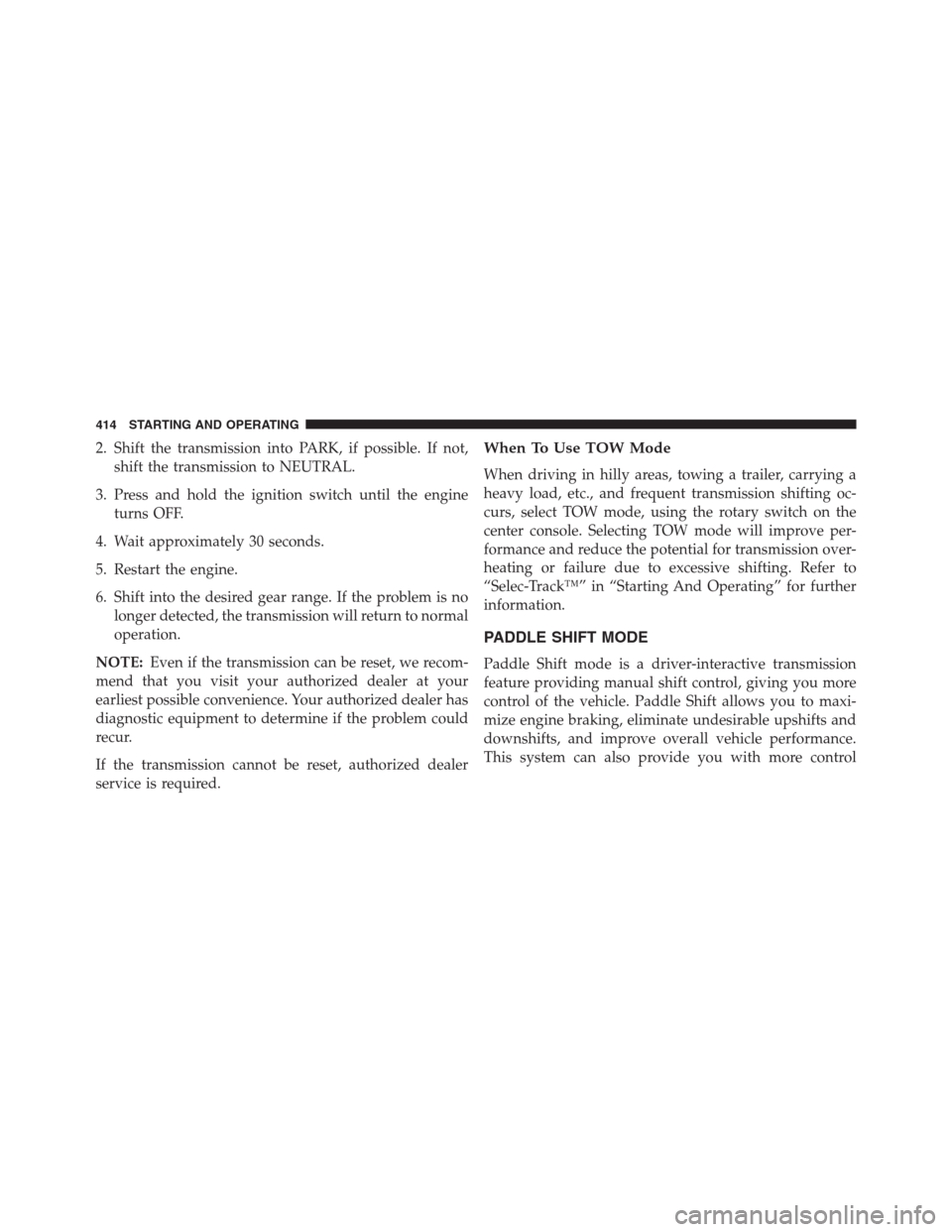Page 398 of 636

▫Flowing/Rising Water..................420
�POWER STEERING.....................422
�FUEL SAVER TECHNOLOGY — IF
EQUIPPED...........................423
�PARKING BRAKE......................423
�BRAKE SYSTEM.......................425
�ELECTRONIC BRAKE CONTROL SYSTEM. . . .426
▫Anti-Lock Brake System (ABS)............426
▫Traction Control System (TCS)............426
▫Brake Assist System (BAS)...............427
▫Electronic Roll Mitigation (ERM)..........428
▫Electronic Stability Control (ESC)..........429
▫ESC Activation/Malfunction Indicator Light And
ESC OFF Indicator Light................433▫Trailer Sway Control (TSC)..............435
�TIRE SAFETY INFORMATION.............436
▫Tire Markings........................436
▫Tire Identification Number (TIN)...........440
▫Tire Terminology And Definitions..........442
▫Tire Loading And Tire Pressure...........443
�TIRES — GENERAL INFORMATION........448
▫Tire Pressure........................448
▫Tire Inflation Pressures.................449
▫Tire Pressures For High Speed Operation. . . .451
▫Radial Ply Tires......................451
▫Tire Types...........................452
▫Run Flat Tires — If Equipped.............454
396 STARTING AND OPERATING
Page 399 of 636

▫Spare Tires — If Equipped...............454
▫Tire Spinning........................457
▫Tread Wear Indicators..................457
▫Life Of Tire.........................458
▫Replacement Tires.....................458
�TIRE CHAINS (TRACTION DEVICES).......460
�TIRE ROTATION RECOMMENDATIONS.....461
�TIRE PRESSURE MONITOR SYSTEM (TPMS) . .463
▫Premium System......................465
▫Tire Pressure Monitoring Low Pressure
Warnings...........................467
▫General Information...................470
�FUEL REQUIREMENTS..................471▫6.4L Engine..........................471
▫Reformulated Gasoline.................471
▫Gasoline/Oxygenate Blends..............471
▫E-85 Usage In Non-Flex Fuel Vehicles.......472
▫MMT In Gasoline.....................472
▫Materials Added To Fuel................473
▫Fuel System Cautions...................473
▫Carbon Monoxide Warnings.............474
�ADDING FUEL........................475
▫Emergency Fuel Filler Door Release.........478
�VEHICLE LOADING....................479
▫Certification Label....................479
�TRAILER TOWING.....................481
5
STARTING AND OPERATING 397
Page 400 of 636
▫Common Towing Definitions.............481
▫Trailer Hitch Classification...............485
▫Trailer Towing Weights (Maximum Trailer Weight
Ratings)............................486
▫Trailer Hitch Receiver Cover Removal (SRT
Models) — If Equipped.................487
▫Trailer And Tongue Weight..............489▫Towing Requirements..................490
▫Towing Tips.........................495
�RECREATIONAL TOWING (BEHIND
MOTORHOME, ETC.)...................497
398 STARTING AND OPERATING
Page 414 of 636

WARNING!
Do not coast in NEUTRAL and never turn off the
ignition to coast down a hill. These are unsafe
practices that limit your response to changing traffic
or road conditions. You might lose control of the
vehicle and have a collision.
CAUTION!
Towing the vehicle, coasting, or driving for any other
reason with the transmission in NEUTRAL can cause
severe transmission damage. Refer to “Recreational
Towing” in “Starting And Operating” and “Towing A
Disabled Vehicle” in “What To Do In Emergencies”
for further information.DRIVE (D)
This range should be used for most city and highway
driving. It provides the smoothest upshifts and down-
shifts, and the best fuel economy. The transmission
automatically upshifts through all forward gears. The
DRIVE position provides optimum driving characteris-
tics under all normal operating conditions.
When frequent transmission shifting occurs (such as
when operating the vehicle under heavy loading condi-
tions, in hilly terrain, traveling into strong head winds, or
while towing heavy trailers), select TOW mode (refer to
�Selec-Track™�in�Starting and Operating�) or use the
Paddle Shift switches (refer to�Paddle Shift Mode�in this
section for further information) to select a lower gear.
Under these conditions, using TOW mode or a lower
gear will improve performance and extend transmission
life by reducing excessive shifting and heat buildup.
412 STARTING AND OPERATING
Page 416 of 636

2. Shift the transmission into PARK, if possible. If not,
shift the transmission to NEUTRAL.
3. Press and hold the ignition switch until the engine
turns OFF.
4. Wait approximately 30 seconds.
5. Restart the engine.
6. Shift into the desired gear range. If the problem is no
longer detected, the transmission will return to normal
operation.
NOTE:Even if the transmission can be reset, we recom-
mend that you visit your authorized dealer at your
earliest possible convenience. Your authorized dealer has
diagnostic equipment to determine if the problem could
recur.
If the transmission cannot be reset, authorized dealer
service is required.When To Use TOW Mode
When driving in hilly areas, towing a trailer, carrying a
heavy load, etc., and frequent transmission shifting oc-
curs, select TOW mode, using the rotary switch on the
center console. Selecting TOW mode will improve per-
formance and reduce the potential for transmission over-
heating or failure due to excessive shifting. Refer to
“Selec-Track™” in “Starting And Operating” for further
information.
PADDLE SHIFT MODE
Paddle Shift mode is a driver-interactive transmission
feature providing manual shift control, giving you more
control of the vehicle. Paddle Shift allows you to maxi-
mize engine braking, eliminate undesirable upshifts and
downshifts, and improve overall vehicle performance.
This system can also provide you with more control
414 STARTING AND OPERATING
Page 417 of 636

during passing, city driving, cold slippery conditions,
mountain driving, trailer towing, and many other situa-
tions.
Operation
When the transmission is in DRIVE or SPORT mode, it
will operate automatically, shifting between the eight
available gears. To activate Paddle Shift mode, simply tap
one of the steering wheel-mounted shift paddles (+/-)
while in DRIVE or SPORT mode. Tapping (-) to enter
Paddle Shift mode will downshift the transmission to the
next lower gear, while using (+) to enter Paddle Shift
mode will retain the current gear. When Paddle Shift
mode is active, the current transmission gear is displayed
in the instrument cluster.
In Paddle Shift mode, the transmission will shift up or
down when (+/-) is manually selected by the driver,
unless an engine lugging or overspeed condition wouldresult. It will remain in the selected gear until another
upshift or downshift is chosen, except as described
below.
•Normally, in Paddle Shift mode, the transmission will
automatically shift up when maximum engine speed is
reached. If, however, Paddle Shift is engaged while in
SPORT or TRACK mode, the transmission will remain
in the selected gear even when maximum engine
speed is reached. The transmission will upshift only
when commanded by the driver.
•The transmission will automatically downshift as the
vehicle slows (to prevent engine lugging) and will
display the current gear.
•The transmission will automatically downshift to first
gear when coming to a stop. After a stop, the driver
should manually upshift (+) the transmission as the
vehicle is accelerated.
5
STARTING AND OPERATING 415
Page 420 of 636

traction with seamless steering feel to provide im-
proved handling and acceleration over two-wheel
drive vehicles. The active suspension system will be in
Touring Mode.
•Track– Track road calibration for use on high traction
surfaces. Driveline is maximized for traction. Some
binding may be felt on less forgiving surfaces. The
electronic brake controls are set to Partial OFF to limit
traction control management of throttle and wheel
spin.
•The transmission will be in SPORT shift mode and
provide a more aggressive shifting pattern. Refer to
“Paddle Shift Mode” in “Starting And Operating”
for further information.
•The customer has the option of going to FULL OFF
with no interaction from the ESC System. The active
suspension system will be in Full Firm mode.
•This feature will reset to AUTO on an ignition cycle.•To w– Use this mode for towing. Vehicle suspension
will go to Firm mode. Trailer sway control is enabled
in the ESC system. The terrain switch will remain in
this position through an ignition cycle until the cus-
tomer cycles into another position. This feature will
reset to AUTO upon an ignition cycle.
Active Damping System
This vehicle is equipped with an electronic controlled
damping system. This system reduces body roll and pitch
in many driving situations including cornering, accelera-
tion and braking. There are 3 modes:
•Touring Mode(Available in terrain positions AUTO
and SNOW) — Used during highway speeds where a
touring suspension feel is desired.
•Firm Mode(Available in terrain positions SPORT and
TOW) — Provides a firm suspension for better han-
dling.
418 STARTING AND OPERATING
Page 428 of 636

brakes will still function. However, the effort required to
brake the vehicle will be much greater than that required
with the power system operating.
ELECTRONIC BRAKE CONTROL SYSTEM
Your vehicle is equipped with an advanced electronic
brake control system that includes the Anti-Lock Brake
System (ABS), Traction Control System (TCS), Brake
Assist System (BAS), Electronic Roll Mitigation (ERM),
and Electronic Stability Control (ESC). All five of these
systems work together to enhance vehicle stability and
control in various driving conditions.
Also, your vehicle is equipped with Trailer Sway Control
(TSC).
Anti-Lock Brake System (ABS)
This system aids the driver in maintaining vehicle control
under adverse braking conditions. The system controlshydraulic brake pressure to prevent wheel lock-up and
help avoid skidding on slippery surfaces during braking.
WARNING!
The ABS cannot prevent the natural laws of physics
from acting on the vehicle, nor can it increase the
traction afforded by prevailing road conditions. The
ABS cannot prevent collisions, including those re-
sulting from excessive speed in turns, driving on
very slippery surfaces, or hydroplaning. The capa-
bilities of an ABS-equipped vehicle must never be
exploited in a reckless or dangerous manner which
could jeopardize the user’s safety or the safety of
others.
Traction Control System (TCS)
This system monitors the amount of wheel spin of each of
the driven wheels. If wheel spin is detected, brake
426 STARTING AND OPERATING